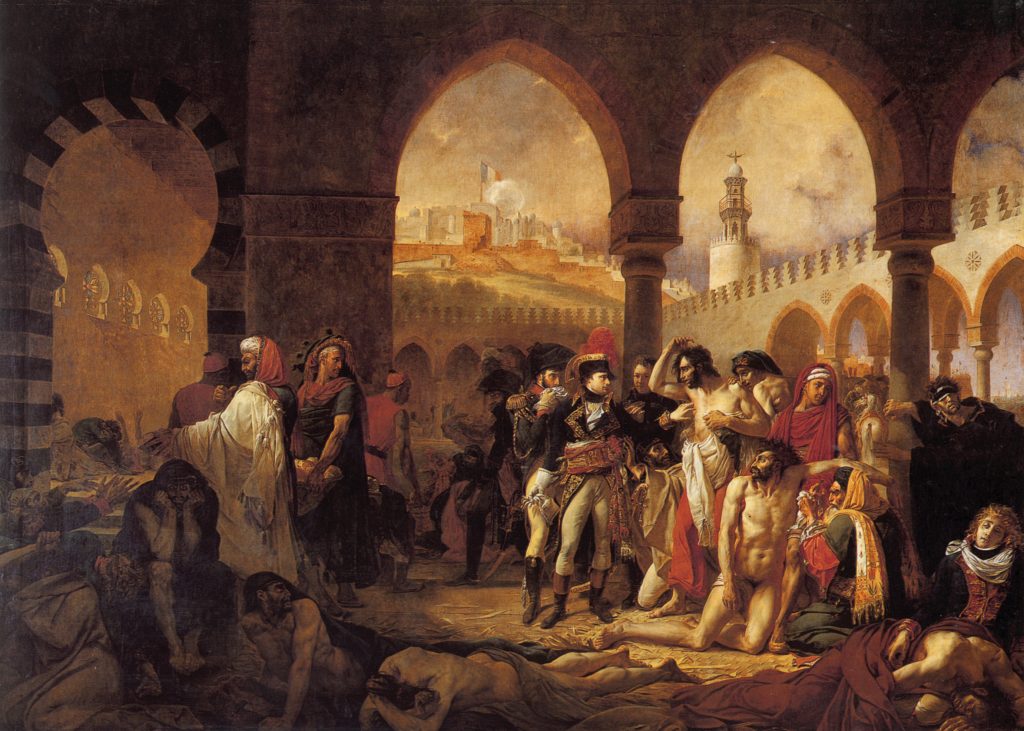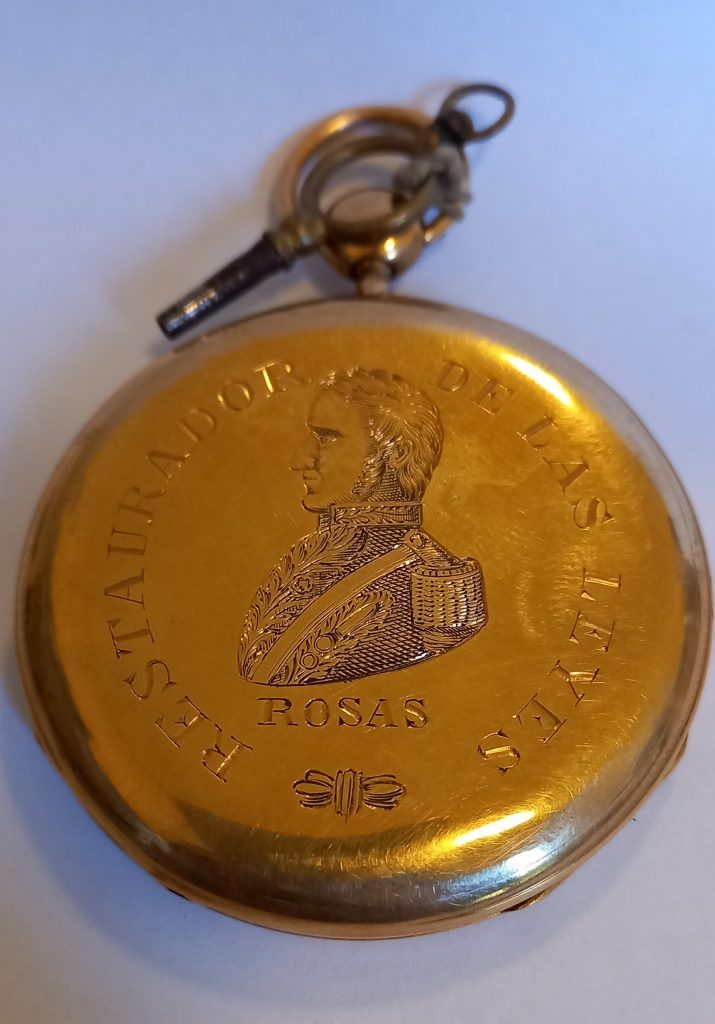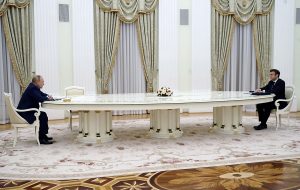 Dr Moisés Prieto is a research associate at the University of Bern. He is a historian of dictatorship, emotions, and migration.
Dr Moisés Prieto is a research associate at the University of Bern. He is a historian of dictatorship, emotions, and migration.
In this guest post for The History of Emotions Blog, he addresses some of the themes from his recent book entitled Narratives of Dictatorship in the Age of Revolution. Emotions, Power and Legitimacy in the Atlantic Space.
We still remember that meeting between French President Emanuel Macron and Vladimir Putin, on 7 February 2022, a few weeks before the Russian invasion of Ukraine. Or rather we remember that enormous meeting table staged to provide a determined political image.
The impact of that image is somehow reflected in the fact, that the table itself has its own Wikipedia entry.[1] The distance between the Russian ruler and his guest becomes a metaphor for the cooler diplomatic relations between the Russian Federation and the West, far from the friendly cordiality of the past. That image reminds us also of the notion of ‘social distance’ which was one of the core issues during the COVID 19 pandemics. It was in fact more a physical distance that health agencies worldwide demanded than anything else.
What is particularly fascinating about the image of those physically (and politically) distant rulers is the twofold message suggested by the imposed distance. Distance can reflect the idea of majestic solemnity, of an unreachable status worth to be honoured and worshipped, but it can also reflect the exact opposite: vulnerability, fear of being attacked and, in Foucauldian terms, le souci de soi. For those who love anagrams, these different interpretations may be condensed in ‘sacred’ versus ‘scared’.
One such scared and suspicious mind was the ruler of Paraguay’s after its independence from the Spanish colonial empire, too. Around 1819, the two Swiss physicians Johann Rengger and Marcel Longchamp arrived in Asunción with the aim to emulate Alexander von Humboldt and to explore the South American flora and fauna. They met Dr José Gaspar Rodríguez de Francia (1766–1840) and described the protocol for audiences as it follows:
This [Francia’s] fear of assassination is also shewn in the etiquette prescribed at his audiences. The person admitted must not approach nearer to the Dictator than six paces, until he makes him a sign to advance; and even then he must always stop at a distance of three paces. His arms must be held close to his body, and his hands open and hanging down, so that it be evident that he has no concealed weapons.[2]
The dictator of Paraguay was peculiar and not necessarily for the above ‘audience choreography’.[3] Unlike the typical heroes of the Latin American independence such as Simón Bolívar, José de San Martín or Antonio José de Sucre, Francia was not a military leader, but a theologian. Furthermore, he was officially proclaimed ‘dictator’ – as the office’s taxonomy – thus echoing the ancient Roman magistrate during the Republic. By then the term was still ‘unpolluted’ and shared little with twentieth-century tyrannies. It was used to evoke instead civic virtues of self-sacrifice and legislatory achievements embodied by historical figures such as Camillus, Cincinnatus, Sulla and Caesar.
During the French Revolution the term ‘dictator’ gained a new impetus and was freed from its historical and philosophical register and entered political language. In more general terms, history itself lost its iterability which was replaced by teleological visions of inexorable progress. Hence, the dictator as conceived in the ancient Roman Republic, who steps in to solve a particular crisis with extraordinary powers, yet for a limited amount of time, gave way to a new idea of dictator who takes over not for the defence of a given constitution, but in the name of one yet to come. The most tangible example for this new paradigm of rule was Napoleon Bonaparte.
Since his seizure of power on the 18 Brumaire (9 November 1799) he had given to France not just military victories, but robust institutions and laws, too. For many liberals all over Europe, Bonaparte embodied the values of the French Revolution. However, things changed with his coronation in 1804. This fall from grace provoked an interesting differentiation. Beethoven, Bolívar, Stendhal and Heine praised the genius of the First Consul Bonaparte, but disdained the self-crowned Emperor Napoleon I as if they were two different personae. Of course, not everybody loved Bonaparte either. On Christmas eve of 1800 he barely survived an assassination attempt. When in 1804 another plot was discovered and the French aristocrat duke d’Enghien considered to be involved in it, Bonaparte did not really hesitate to order his abduction, imprisonment and – after a mock trial – his execution. Eventually, d’Enghien had nothing to do with the plot. Once exiled on St Helena, more than a decade later, Napoleon justified the political murder as it follows:
I should still have had the right of the law of nature, of legitimate self-defence. The Duke [of Enghien] and his party had constantly but one object in view, that of taking away my life. I was assailed on all sides, and at every instant; air-guns, infernal machines, plots, ambuscades of every kind, were resorted to for that purpose. At last I was tired out, and took an opportunity of striking them with terror in their turn in London; I succeeded, and from that moment there was an end to all conspiracies. Who can blame me for having acted so?[4]
These words recall that the terror one instils reflects the fear one experiences.[5] And speaking of fear, is there any other fear than that of death? Bonaparte, worshiped by his supporters almost like a god, immortalised like a Roman divinity and a Messiah, was aware of his mortality.

Figure 2: Bonaparte Visiting the Pesthouse in Jaffa (1804), by Antoine-Jean Gros, Public domain, via Wikimedia Commons.
Unlike monarchs, dictators lack a ‘body politic’. They cannot perpetuate themselves beyond their death through a dynasty. Yet while the dictator might envy the monarch for this, the monarch is likely to envy the dictator, too, yet for his charisma and his freedom of action, generally not limited by any constitution or customary law. In other words, emotions become relevant factors for the sake of legitimising these new rulers. As David Bell eloquently puts it:
The intense emphasis now placed on the emotional bond between rulers and ruled was something new, and it meant that the revolutionary leaders were in no sense simply substitute kings. Their political authority was of a fundamentally different sort.[6]
Another ruler with such a fundamentally different sort of authority was the governor of the Province of Buenos Aires, Brigadier General Juan Manuel de Rosas (1793–1877). Originally a cattle-breeder, he became in 1829 governor and again in 1835 – this time with the sum of public power. His charismatic personality was attested by nobody less than Charles Darwin who met him in 1833 and whose ‘sinister’ attraction is palpable in the following quote: “General Rosas is a man of an extraordinary character; he has at present a most predominant influence in this country & probably may end by being its ruler.”[7]

Figure 3: Golden pocket watch with Juan Manuel de Rosas’ portrait engraved. Courtesy of Museo Histórico Nacional (Buenos Aires), inventory number. MHN 2446.
Darwin could certainly not predict the utmost terror of Rosas’ second rule and the activities of the paramilitary force – the infamous Mazorca – which persecuted the dictator’s enemies, mainly located among the liberal and Europhile unitarians. Strict political control was articulated by means of powerful emotional practices. The dictator was hailed in what John Lynch called an “orgy of adulation”[8], with his portrait displayed in the churches of Buenos Aires, next to the crucifix. The use of colours, too, contributed to show a ‘generally recommendable’ allegiance to the governor. Red became the official colour every citizen – who cared for his/her own life – had to wear on his chest or on her hair. The effigy of Rosas became ubiquitous and, in some cases, perennial as the governor’s engraved portrait on pocket watches indicates. If a given uniformity in red was prescribed, other colours were forbidden like sky-blue and green, and, to the widows and orphans of his assassinated enemies it was prohibited to mourn. A pristinely paradigmatic ‘emotional regime’ (Reddy) with restrains and commandments was, therefore, reigning in Buenos Aires.
Rosas’ detractors like Domingo Faustino Sarmiento or José Rivera Indarte, a former supporter of the governor, used the word ‘terror’ to refer to his regime; an idea which was reconducted to the experience under the French Revolution. Sarmiento wrote in his seminal essay Facundo:
What happens is that terror is a disease of the mind that attacks a people like cholera, smallpox, or scarlet fever. No one, finally, escapes the contagion. And when work is done for ten straight years to inoculate it, even those already vaccinated cannot resist in the end.[9]
Hence, terror was no longer a Machiavellian mean to punctually ‘promote’ the people’s loyalty through single executions. As Reinhart Koselleck argued, it allowed now (post-)revolutionary regimes to pervade the realm of the private, thus penetrating homes, bodies and minds in an unprecedented way,[10] thus blurring the borders between the private and the public.
Rosas was finally overthrown after the Battle of Caseros in 1852 and fled to Great Britain where he spent the rest of his life in Southampton. All his efforts to perpetuate himself in power were in vain, facing eventually the same fate as Bolívar and Napoleon.
Generally, the tyrant leaving the floor is the best part of his regime. Supporters will certainly miss him and sometimes even detractors, unhappy and disenchanted by what came after him, might reconsider his deeds. If history loses its potential of providing guidance and its iterability, it becomes exceptional and, therefore, those ‘great men’ who shape history – in Carlylean terms – are perceived as exceptional too. The passing away of the exceptional and the unique produces inevitably a feeling of loss and pain.

Figure 4: Louis-Philippe inaugurant la statue de Napoléon sur la colonne Vendôme (19th century), by Carlo Canella (1800-1879), Public domain, via Wikimedia Commons.
This nostalgia, which had little to do with its originally pathologic meaning, had multiple expressions paving the path to a post-Napoleonic cult. Veterans gathering in their old uniforms at the foot of the Vendôme column, the consumption of emotional objects such as relics, statuettes, images and hidden faces of the late Emperor shows a longing for a (mythical) return of the hero. Starring back at those ‘good old days’ was a side effect of the new conception of linear and teleologic history.[11] Nevertheless, nostalgia was not only about the past. As Svetlana Boym claimed: “Fantasies of the past determined by needs of the present have a direct impact on realities of the future.”[12] No wonder that the longing for Napoleon the Great helped his nephew Louis-Napoleon – ‘Napoléon le Petit’, as Victor Hugo called him – becoming the ruler of France.
Dictators bear a sinister fascination, comparable to what cancer types might experience on oncologists. Studying those emotions inculcated and disseminated by them and those sentiments which affect them opens new ways of understanding how dictatorships function and why such a pernicious rule still exists. Dictators around 1800, on both sides of the Atlantic, show the transformation from the honourable, selfless citoyen taking the reins of the state for a higher purpose and paying his tribute to the ancient Roman model, towards an unlimited and uncontrolled concentration of power for the sake of itself and the dictator’s self-aggrandisement. Still echoing and obliged to the prestigious Roman tradition, they impose their iron will upon the population. Nowadays, autocrats generally present themselves as true democrats, but once in office they abridge civil rights and abolish those constitutional hurdles which impede them to perpetuate themselves in power. These steps must be followed by determined messages addressed to the people for the sake of quietening any criticism and presenting the ruler’s actions as necessary for the country’s safety, glory and happiness. It is in these messages where emotions operate and maintain a key role.
References
Vladimir Putin’s meeting table, https://en.wikipedia.org/wiki/Vladimir_Putin%27s_meeting_table, consulted on 26 March 2023.
Moisés Prieto, Narratives of Dictatorship in the Age or Revolution. Emotions, Power and Legitimacy in the Atlantic Space (London: Routledge, 2023).
Johann R. Rengger and Marcel Longchamps, The Reign of Doctor Joseph Gaspard Roderick de Francia (London: Thomas Hurst, Edward Chance & Co., 1827).
Memoirs of the Life, Exile and Conversations, of the Emperor Napoleon by the Count de Las Cases, 4 vols. (London: Henry Colburn, 1836).
Stefan Rinke, ‘The epitome of modern dictatorship in the early nineteenth century. Dr Francia in Paraguay, or «The Chinese emperor of the West»,’ in Dictatorship in the Nineteenth Century. Conceptualisations, Experiences, Transfers, ed. Moisés Prieto (London: Routledge, 2021), p. 133–49.
David A. Bell, Men on Horseback. The Power of Charisma in the Age of Revolution (New York: Farrar, Straus and Giroux, 2020).
Charles Darwin, ‘Diary of the Voyage of H.M.S. Beagle,’ in: The Works of Charles Darwin, ed. Nora Barlow, 29 vols., vol. 1 (London: Pickering & Chatto, 1986).
John Lynch, Argentine Dictator: Juan Manuel de Rosas 1829–1852 (Oxford: Clarendon Press, 1981).
Domingo Faustino Sarmiento, Facundo. Civilization and Barbarism, trans. Kathleen Ross (Berkeley, Los Angeles, London: University of California Press, 2003).
Reinhart Koselleck, Critique and Crisis. Enlightenment and the Pathogenesis of Modern Society (Cambridge MA: The MIT Press, 1988).
Svetlana Boym, The Future of Nostalgia (New York: Basic Books, 2001).
[1] Vladimir Putin’s meeting table, https://en.wikipedia.org/wiki/Vladimir_Putin%27s_meeting_table, 26 March 2023.
[2] Johann R. Rengger and Marcel Longchamps, The Reign of Doctor Joseph Gaspard Roderick de Francia (London: Thomas Hurst, Edward Chance & Co., 1827), p. 201–2.
[3] Stefan Rinke, «The epitome of modern dictatorship in the early nineteenth century. Dr Francia in Paraguay, or ‘The Chinese emperor of the West’,» in Dictatorship in the Nineteenth Century. Conceptualisations, Experiences, Transfers, ed. Moisés Prieto (London: Routledge, 2021), p. 133–49, p. 133–34.
[4] Memoirs of the Life, Exile and Conversations, of the Emperor Napoleon by the Count de Las Cases, 4 vols. (London: Henry Colburn, 1836), iv: p. 191.
[5] Moisés Prieto, Narratives of Dictatorship in the Age or Revolution. Emotions, Power and Legitimacy in the Atlantic Space (London: Routledge, 2023), p. 117.
[6] David A. Bell, Men on Horseback. The Power of Charisma in the Age of Revolution (New York: Farrar, Straus and Giroux, 2020), p. 10.
[7] Charles Darwin, ‘Diary of the Voyage of H.M.S. Beagle,’ in: The Works of Charles Darwin, ed. Nora Barlow, vol. 1 (London: Pickering & Chatto, 1986), p. 149.
[8] John Lynch, Argentine Dictator: Juan Manuel de Rosas 1829–1852 (Oxford: Clarendon Press, 1981), p. 183.
[9] Domingo Faustino Sarmiento, Facundo. Civilization and Barbarism, trans. Kathleen Ross (Berkeley, Los Angeles, London: University of California Press, 2003), p. 135.
[10] Reinhart Koselleck, Critique and Crisis. Enlightenment and the Pathogenesis of Modern Society (Cambridge MA: The MIT Press, 1988), p. 164–65.
[11] Svetlana Boym, The Future of Nostalgia (New York: Basic Books, 2001), p. 10.
[12] Ibid., p. xvi.


